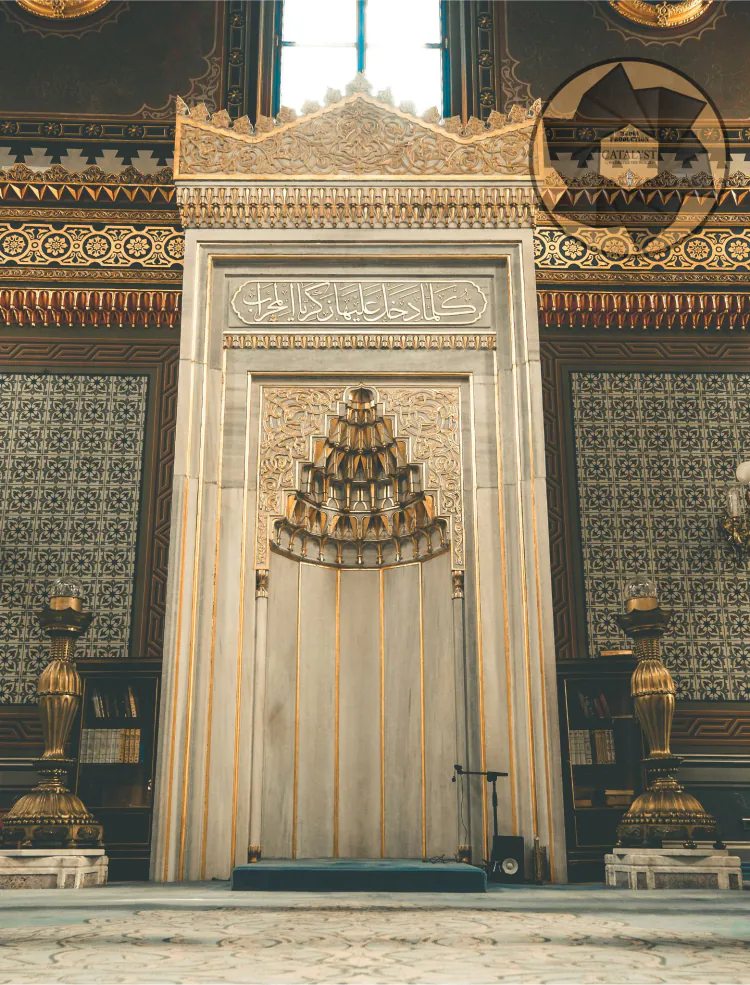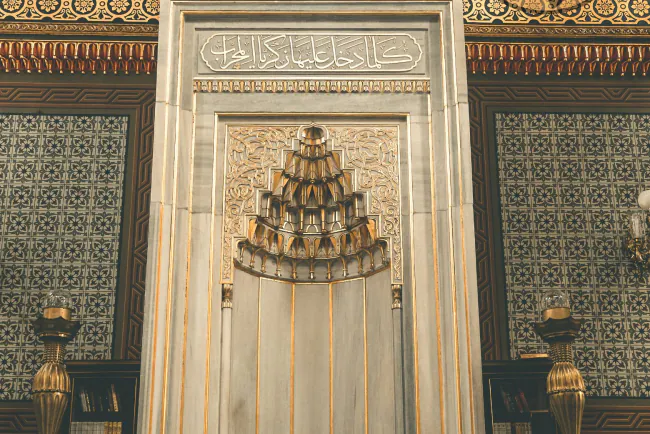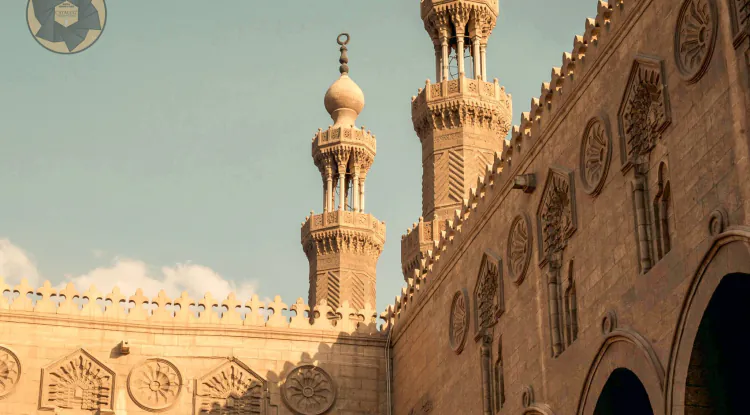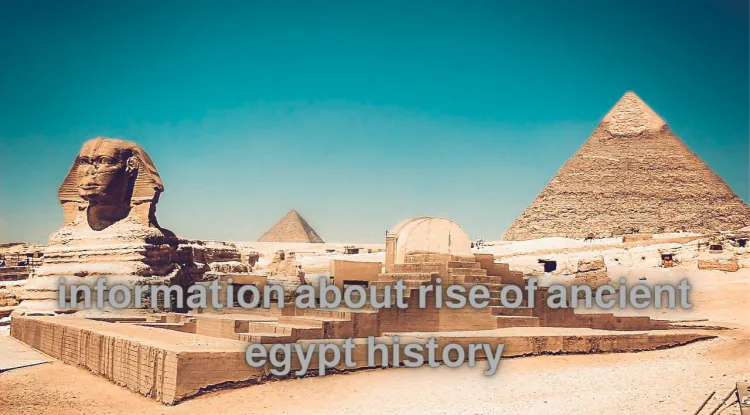The origins and development of the pulpit in Islamic architecture
The pulpit ; It is a high building on which the sermon is read in a mosque or masjid. In general, it was built to architecturally match the right side of the mihrab inside the mosque. The pulpit, designed with a staircase so that the imam can address those praying from a high place, has an integrated structure within the mosque.

What is the pulpit ?
Although the pulpit or (minbar), which is made of wood, is considered a type of minor or subsidiary art, it is considered one of the oldest and most important elements of the mosque. The importance of the pulpit in relation to the first Islamic mosques is summarized in that it was the distinctive sign of the Grand Mosque, that is, the large mosque in the city in which the sermon is held before prayer, usually Friday prayer, Although it could have dealt with a matter of public affairs: political, economic, or social, or to be a program for governance or an announcement of some important governmental political decisions, which were usually published from the top of the pulpit, and were sometimes hung on the door of the mosque.
what is the purpose of a pulpit ?
What is understood from the texts is that the Prophet had taken a palm trunk in his mosque in Medina to sit on or lean on when addressing his companions, then he had taken a pulpit with three steps on which he used to sit for the sermon. When Abu Bakr became the first Caliph and successor of the Prophet, he sat on the second step of the pulpit out of respect for the place where the Prophet was sitting, and when Omar ibn al-Khattab became the Caliph and successor, he sat on the first step out of respect for the Messenger and his first caliph.
Here there is no harm in referring to what the narrations state that Omar ibn al-Khattab rejected what Amr ibn al-Aas did of taking a pulpit in the Fustat Mosque, and said to him: Is it not enough for you to stand while the Muslims are sitting? Then he asked him to break it. In this regard, it was said that the pulpit represents the bishop’s seat in the great church (the cathedral) and the king’s throne together, which is the dual function of the caliphs.
More importantly, leaving the upper level of the pulpit vacant after its levels increased and its elements were integrated became a practiced tradition followed by the caliphs out of reverence for the place that the Prophet occupied at the top of the pulpit. However, some give this matter a symbolic significance linking it to the idea of the Awaited Imam. In that Burkart says: The empty upper step represents the invisible presence of the mind in Buddhism and Christianity or the hidden presence of the divine messenger.
The truth is that Muawiyah increased the levels of the Prophet’s pulpit, making them seven by taking four new levels and making them the base for the Prophet’s pulpit, and although the Mahdi made an attempt to return to the Sunnah again when he ordered in the year (161 AH / 778 AD) to shorten the pulpits and make them as long as the Prophet’s pulpit was, That is, by three steps, the steps of the pulpit increased since the days of the Seljuks, so it became seven steps and eleven steps, and thus the pulpit took its final form that we know now.
It is important to point out that the pulpit - like the mihrab - received great attention from Muslim woodworking artists. The pulpit was made of small conical wood of many shapes, and the methods of interlacing it into panels (fillings) with strange geometric shapes varied, from squares, circles and shapes. Swastikas, stars, etc. The number of turned, carved, and carved wooden pieces in the precious pulpit reached many thousands, and because Egypt lacked good types of wood, this led to a focus on small pieces and their use in appropriate artistic subjects.
We would like to point out that the small-sized wooden elements, whether carved, engraved or engraved, are considered among the characteristics of authentic art due to the effort, skill and sacrifice involved. The price of a well-made pulpit reached thousands of dinars, and if it was the pulpit of Kairouan, it is one of the oldest examples that have reached us. It is considered one of the examples of Iraqi art, as the Abbasid Caliphate sent it from the East as an expression of reverence for the Uqba Ibn Nafi Mosque, and appreciation at the same time for the ruling majority family in African countries in the name of the legitimate caliphate in Baghdad. It is known that the Moroccans and Andalusians took great care of the pulpits, spending a lot of money on them, and encouraging Skilled craftsmen are creative in it.
Thus, Imam Idris was interested in creating a pulpit for the Mosque of Tlemcen, in which he recorded the date of its manufacture, which was (174 AH / 790 AD). The Umayyad caliphs in Andalusia were also interested in the pulpit of the Mosque of Cordoba, which gained great fame. It was part of the Moroccans’ care for their pulpits that they did not leave them exposed in the house of prayer(qibla riwaq), but rather allocated them to them. A room beyond the wall of the qibla. It is as if they modified the construction of that wall. They also provided the pulpits with wheels that would slide on them when they were drawn outside to the house of prayer (qibla riwaq) before Friday and when they returned to their room again after prayer. An example of this is the pulpit of Marrakesh during the era of Abd al-Mu’min al-Mawhad, and some people thought about that. The pulpit would go out to the house of prayer in an automatic manner when the imam approached it, and that it would return to it after prayer in the same automatic way as well.
It is most likely that rumors spread about the details of this imaginary mechanical trick, as we think, and there is no harm in pointing out here that the work of this pulpit wood is considered, thanks to the precision of its workmanship, the fineness of its assembly and the transparency of its fillings, to be examples of true religious art, even though the manufacture of turned, carved and engraved wood has become thanks to its transparency. His relative paintings are focused on making mashrabiyas in homes and palaces.
What's Your Reaction?






















